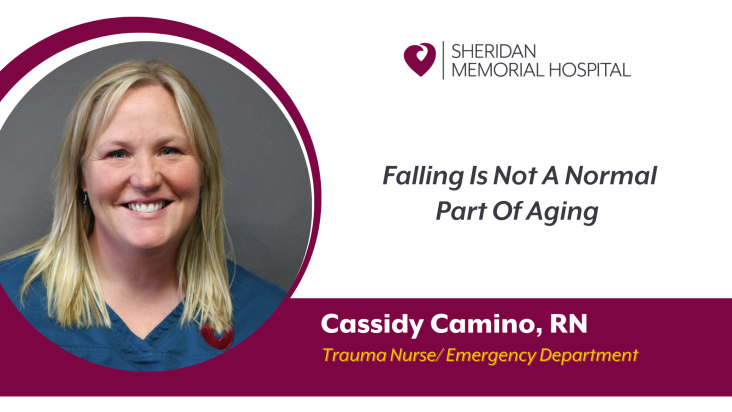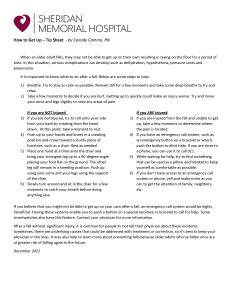By Cassidy Camino, Sheridan Memorial Hospital Trauma RN
According to the CDC:
- More than 1 in 4 people 65 and older in the US fall each year.
- Falls are the leading cause of injury-related death among adults 65 and older.
In our community, the most common causes of injury for 65 and older are injuries from falls – falling is not a normal part of aging. Per the Sheridan Memorial Hospital (SMH) trauma statistics, from November 2021 to November 2022, 125 of the 138 patients in this age group sustained injuries from falling that were significant enough for hospital admission or transfer to a larger trauma center. Sixty-two of those resulted in hip fractures, and 15 resulted in head injuries.
Seniors are at an increased risk for many types of injuries due to advancing age and decreasing health. As we age, our eyesight, hearing, and reflexes might not be as sharp as they were when we were younger. Certain conditions, such as diabetes, heart disease, or problems with your thyroid, nerves, feet, or blood vessels, can affect your balance and lead to a fall. Certain medications can cause you to feel light-headed and dizzy. Review your medications with your provider.
Falling once increases the chances of falling again. Many people who fall develop a fear of falling again, and this fear causes them to be less active. Being less active causes increased weakness and raises the chance of falling again. This is why it is vital for seniors to keep moving. Many types of exercises or movements can help develop better muscle tone to improve balance and gait.
Many people believe that falls are an inevitable part of aging. However, this is not true, and many falls can be prevented by being aware of hazards and taking some simple steps to correct them. Below are some tips to prevent falls in and out of the home.
Remove home hazards:
- Remove things you might trip over, such as books/newspapers, cords and shoes.
- Remove loose rugs or secure them with double-faced tape.
- Replace worn carpet.
- Keep areas brightly lit to avoid tripping on hard-to-see objects.
- Place nightlights in bathrooms and hallways.
- Turn on the lights before going downstairs.
- Store flashlights in easy-access places in case of power outages.
- Consider changing your footwear. Slippers, stocking feet, backless shoes and shoes with slick soles can make you stumble and fall. Wear properly fitted shoes with nonskid soles.
- Make your bathroom more user-friendly.
- Install raised toilet seats or one with armrests.
- Install grab rails near the shower/tub and next to the toilet
- Use non-slip mats in the bathtub and on shower floors.
- Use a sturdy plastic seat for the shower or tub and a hand-held shower nozzle for bathing while sitting down.
Staying safe in our Wyoming Weather:
- For wet, slick or snowy weather, wear shoes with irregular texture on the soles for the best grip possible. Use Yaktrax, which easily slip over your shoes and boost your traction.
- Clean your boots and shoes after you are inside. Leftover ice and snow can stay on for some time and make the shoes slick the next time you put them on.
- Give yourself plenty of time to get to where you are going.
- Use a grip whenever possible. For example, use handrails when available or the door handle when getting out of the car. Utilize gloves to better grip canes, walkers and railings.
- Keep your hands free of objects, so you’re as stable as possible.
- Look over your walking options for the safest paths.
- Check that your walkers and canes are in good shape from top to bottom. Sometimes they have a tip at the bottom with a retractable ice pick.
If you believe you might not be able to get up on your own after a fall, an emergency call system would be highly beneficial. This system enables you to push a button on a special necklace or bracelet to call for help. Some smartwatches also have this feature. Contact your physician for more information.
Injuries among this age group can have devastating consequences, in some cases leading to disability, loss of independence and death. Preventing injuries is the easiest way to protect your health and promote successful aging.
Click here to learn more about Emergency Services at Sheridan Memorial Hospital.
How to Get Up – Tip Sheet
When an older adult falls, they may not be able to get up on their own resulting in laying on the floor for a period of time. In this situation, serious complications can develop such as dehydration, hypothermia, pressure sores and pneumonia.
It is important to know what to do after a fall. Below are some steps to help.
- Breathe. Try to stay as calm as possible. Remain still for a few moments and take some deep breaths to try and relax.
- Take a few moments to decide if you are hurt. Getting up to quickly could make an injury worse. Try and move your arms and legs slightly to note any areas of pain.
If you are NOT Injured
- If you are not injured, try to roll onto your side from your back by rotating from the head down. At this point, take a moment to rest.
- Push up to your hands and knees in a crawling position and crawl toward a sturdy piece of furniture, such as a chair. Rest as needed.
- Place one hand at a time onto the chair and bring your strongest leg up to a 90-degree angle placing your foot flat on the ground. The other leg will remain in a kneeling position. Push up using your arms and your legs using the support of the chair.
- Slowly turn around and sit in the chair for a few moments to catch your breath before doing anything else.
If you ARE Injured
- If you are injured from the fall and unable to get up, take a few moments to determine where the pain is located.
- If you have an emergency call system, such as an emergency button on a bracelet or watch, push the button to elicit help. If you are close to a phone, you can use it to call 911.
- While waiting for help, try to find something that can be used as a pillow and blanket to keep yourself as comfortable as possible.
- If you don’t have access to an emergency call system or phone, yell and make noise as you can to get the attention of family, neighbors, etc.
If you believe that you might not be able to get up on your own after a fall, an emergency call system would be highly beneficial. Having these systems enable you to push a button on a special necklace or bracelet to call for help. Some smartwatches also have this feature. Contact your physician for more information.
After a fall without significant injury, it is common for people to not tell their physician about these incidents. Sometimes, there are underlying causes that could be addressed with treatment or correction, so it’s best to keep your physician in the loop. It may also help to learn more about preventing falls because older adults who’ve fallen once are at greater risk of falling again in the future.


